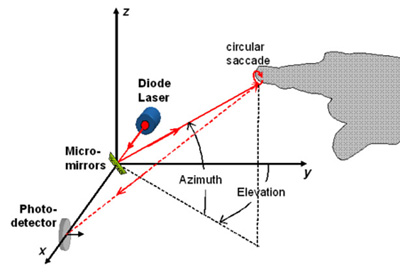On a quest to discover the latest new and cool wireless technologies coming down the pike, yesterday I made a quick scan of exhibitors at the upcoming Wired NEXTFEST. Most didn’t seem related to wireless/mobility per se, but one product that did catch my eye is a new laser-based user interface application developed by three Japanese engineers.
Titled “Smart Laser Scanner for Human-Computer Interface,” the new technology is designed to address the challenge of inputting information into electronic devices as those devices become smaller and smaller. The approach taken by the Japanese developers is to use a “a simple active tracking system using a laser diode (visible or invisible light), steering mirrors, and a single non-imaging photodetector, which is capable of acquiring three dimensional coordinates in real time without the need of any image processing at all.”
Wow, pretty technical stuff!
The engineers who developed this technology further describe it as “a smart rangefinder scanner that instead of continuously scanning over the full field of view, restricts its scanning area, on the basis of a real-time analysis of the backscattered signal, to a very narrow window precisely the size of the target.”
The demo pages for this new technology are pretty technical, but the images are cool. (Guess it’s truer than ever that, sometimes, a picture is worth a thousand words.) Essentially it appears that laser technology is used to allow input into electronic devices using hand/finger movements.
According to the developers, this laser-based input has several key advantages:
+ Few constraints on the user and environment (doesn’t require special projectors or other devices)
+ Real-time, full 3D acquisition (no stereoscopic camera needed to track three-dimensional data)
+ System-on-a-chip integration (using MOEMS technology, it’s possible to integrate the entire system onto a single chip for mobile devices)
What will they think of next?








